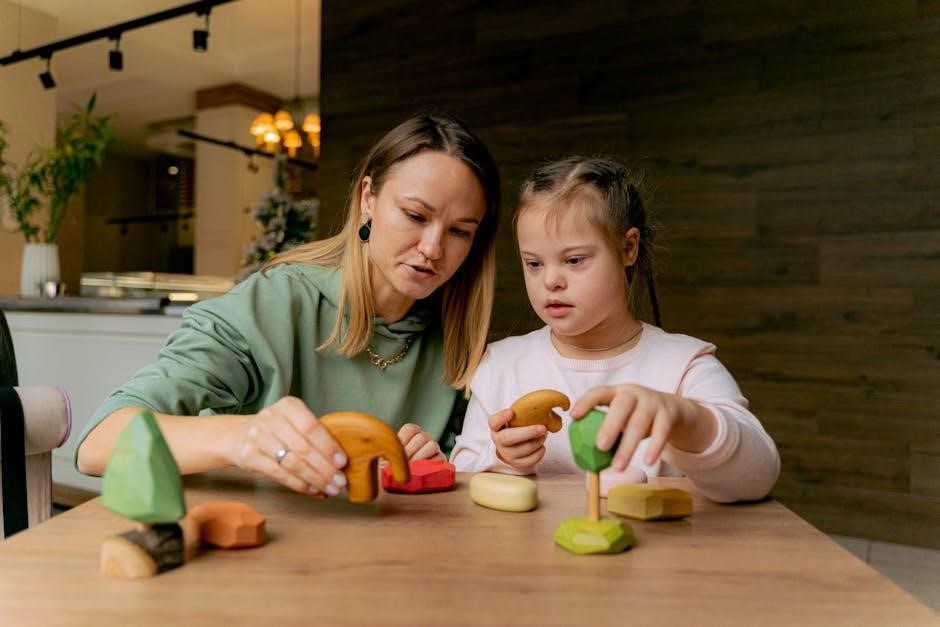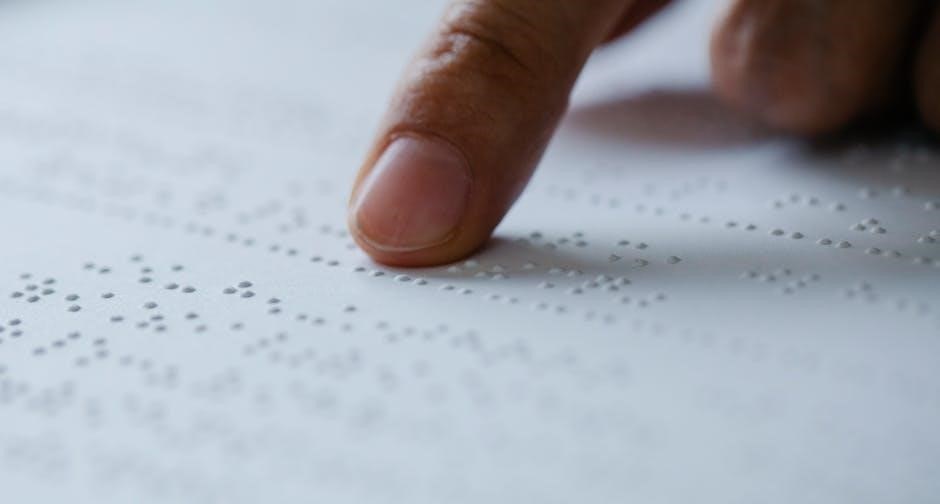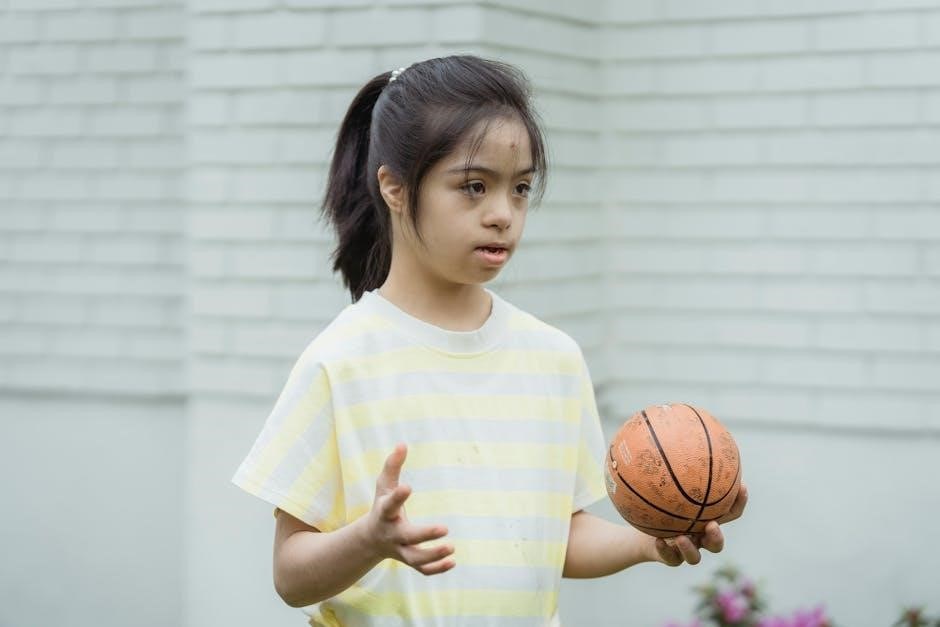An Individualized Education Program (IEP) is a personalized plan designed to meet the unique needs of students with learning disabilities. It ensures they receive tailored support and accommodations to access the curriculum effectively, fostering academic and functional growth.

1.1. What is an IEP?
An Individualized Education Program (IEP) is a written plan developed for students with disabilities to ensure they receive specialized instruction and related services. It outlines academic and functional goals tailored to the student’s unique needs, ensuring access to a free and appropriate public education (FAPE). The IEP is created by a team of educators, parents, and specialists, focusing on the student’s strengths, challenges, and learning style. It is annually reviewed and updated to reflect progress and evolving needs, serving as a roadmap for the student’s educational journey.
1.2. Importance of IEP for Learning Disabilities
An IEP is crucial for students with learning disabilities as it ensures they receive tailored support and accommodations to access the curriculum. It addresses specific needs, fostering academic and functional growth. The IEP guarantees a free and appropriate public education (FAPE), enabling students to thrive in the least restrictive environment. By outlining measurable goals and interventions, it empowers educators and parents to collaborate effectively. This personalized approach helps students overcome challenges, build confidence, and achieve their full potential, ensuring equitable learning opportunities and long-term success.

Legal Framework Governing IEPs
The Individuals with Disabilities Education Act (IDEA) 2004 ensures that students with disabilities receive a Free and Appropriate Public Education (FAPE) through legally binding IEPs.
2.1. Individuals with Disabilities Education Act (IDEA) 2004
The Individuals with Disabilities Education Act (IDEA) 2004 mandates that all eligible students with disabilities receive specialized instruction and related services tailored to their unique needs. This federal law ensures that every child, regardless of disability, has access to a Free and Appropriate Public Education (FAPE). IDEA emphasizes collaboration between parents, educators, and service providers to develop and implement Individualized Education Programs (IEPs). These plans outline specific goals, accommodations, and services to support students in achieving academic success and functional skills, aligning with the legal framework that protects their educational rights.
2.2. Free Appropriate Public Education (FAPE)
Free Appropriate Public Education (FAPE) is a cornerstone of the Individuals with Disabilities Education Act (IDEA) 2004, ensuring students with disabilities receive an education tailored to their unique needs at no cost. FAPE is delivered through an IEP, which outlines specialized instruction, related services, and accommodations. This legal right guarantees that students with learning disabilities have access to the general education curriculum, supplementary aids, and supports necessary for their progress. FAPE ensures that every student, regardless of disability, is prepared for further education, employment, and independent living by addressing their individual needs effectively.
Key Components of an IEP
An IEP includes present levels of achievement, measurable annual goals, special education services, accommodations, progress monitoring, and the IEP team, ensuring a comprehensive, tailored plan for the student.
3.1. Present Levels of Academic Achievement and Functional Performance

This section outlines the student’s current academic and functional abilities, identifying strengths, needs, and how their disability impacts access to the curriculum. It includes assessments, educational concerns, and how the disability affects participation in activities, linking directly to IEP goals and accommodations.
3.2. Measurable Annual Goals
Measurable Annual Goals are specific, achievable objectives tailored to address the student’s academic, functional, or behavioral needs. These goals are clear, time-bound, and aligned with grade-level standards or functional skills. They are crafted to ensure progress toward independence, accessing the curriculum, and overcoming challenges posed by the disability. Goals are developed collaboratively by the IEP team and include criteria for measuring success, such as benchmarks or assessments. Regular progress monitoring ensures goals are met or adjusted as needed, with updates shared with parents and the IEP team to track the student’s advancement effectively.
3.3. Special Education Services and Supports

Special Education Services and Supports are tailored interventions and resources provided to students with learning disabilities to ensure access to the curriculum. These may include small group instruction, resource support, assistive technology, speech therapy, or behavioral interventions. Services are designed to address specific needs, such as reading comprehension, math skills, or social interactions. Supports like extended time, graphic organizers, or note-taking assistance help students overcome challenges. The IEP team collaborates to determine the frequency, duration, and setting for these services, ensuring they are aligned with the student’s goals and classroom activities to promote meaningful progress and independence.
3.4. Accommodations and Modifications
Accommodations and modifications are adjustments made to help students with learning disabilities access the curriculum and demonstrate their knowledge. Accommodations, such as extended time, graphic organizers, or assistive technology, do not alter the content but provide support. Modifications involve changes to the content, such as simplified reading materials or alternative assignments, to meet individual needs. These adjustments are tailored to the student’s specific requirements and are documented in the IEP to ensure consistency across settings. The IEP team determines which accommodations and modifications are necessary based on the student’s strengths, challenges, and goals, ensuring they are implemented effectively to promote learning and success.
3.5. Progress Monitoring and Reporting
Progress monitoring and reporting are crucial for tracking a student’s advancement toward their IEP goals. Regular assessments, such as quizzes, projects, and performance tasks, provide data on the student’s progress. Reports are typically shared with parents through quarterly progress reports or more frequent updates, detailing achievements and areas needing additional support. These reports also highlight any necessary adjustments to the IEP, ensuring the student remains on track to meet their annual goals. Consistent communication between teachers, parents, and the IEP team is essential to adapt strategies and maintain alignment with the student’s learning objectives.
3.6. The IEP Team
The IEP team is a collaborative group responsible for developing, implementing, and monitoring the Individualized Education Program. Key members include parents, general education teachers, special education teachers, school administrators, and related service providers like speech or occupational therapists. Each member brings unique perspectives and expertise to ensure the student’s needs are comprehensively addressed. The team works together to set goals, design interventions, and evaluate progress, fostering a coordinated approach to the student’s education. Their collective input ensures the IEP is tailored to the student’s specific requirements, promoting academic and functional growth.

Creating a Sample IEP PDF

A sample IEP PDF provides a structured template for documenting a student’s goals, services, and accommodations. It ensures clarity and organization, aiding educators and parents in developing effective plans.
4.1. Structuring the IEP Document
Structuring an IEP document involves organizing key components to ensure clarity and compliance. Begin with student demographics, followed by present levels of academic and functional performance. Next, outline measurable annual goals tailored to the student’s needs, including academic, functional, and behavioral objectives. Detail special education services, accommodations, and modifications. Include progress monitoring strategies and reporting methods. Finally, document the IEP team members and their roles. This structured approach ensures all aspects of the student’s education are addressed systematically, providing a clear roadmap for implementation and review.
4.2. Customizing the IEP to Meet Individual Needs
Customizing an IEP involves tailoring the document to address the unique needs, strengths, and challenges of the student. This includes incorporating specific learning strategies, accommodations, and modifications based on the student’s learning style and disability. For example, a student with dyslexia might require multisensory instruction, while another with ADHD may need behavioral supports. The IEP should also reflect the student’s interests and preferences to enhance engagement. By integrating feedback from parents, educators, and the student, the IEP becomes a personalized roadmap for achieving academic and functional goals, ensuring the student receives the right support to thrive.

4.3. Best Practices for IEP PDF Layout
A well-structured IEP PDF enhances readability and ensures all components are easily accessible. Use clear headings, subheadings, and bullet points to organize information logically. Incorporate page numbers and a table of contents for quick navigation. Ensure consistent formatting, such as font style and size, throughout the document. Use bold or italic text sparingly to emphasize key sections. Include visuals like charts or graphs if they aid understanding. Ensure the PDF is searchable and accessible, with proper spacing and margins. Finally, proofread for clarity and accuracy to maintain a professional appearance.

Sample Sections of an IEP
IEPs typically include sections like academic goals, functional goals, and behavioral goals, each tailored to address specific needs and track progress effectively for students with learning disabilities.
5.1. Academic Goals
Academic goals in an IEP are specific, measurable objectives tailored to a student’s learning needs. They address skills in reading, writing, math, and other core subjects. These goals are designed to help students with learning disabilities progress toward grade-level standards. For example, a goal might focus on improving reading comprehension or mastering multiplication facts. Goals are developed collaboratively by the IEP team, incorporating baseline data and assessments. They include criteria for mastery and timelines for achievement, ensuring the student receives targeted support to meet their educational needs effectively.
5.2. Functional Goals
Functional goals in an IEP focus on skills that enhance a student’s independence and daily living. These goals address practical abilities like organization, time management, and self-advocacy. For students with learning disabilities, functional goals might include using a planner to track assignments or requesting help when needed. These goals are often linked to real-life situations, ensuring the student can apply skills across different settings. They are measurable and tailored to the student’s specific needs, promoting long-term independence and success both in and out of the classroom.
5.3. Behavioral Goals
Behavioral goals in an IEP address specific challenges a student with learning disabilities may face, such as impulsivity, social interactions, or emotional regulation. These goals are designed to reduce barriers to learning and promote positive behaviors. For example, a goal might focus on the student using strategies to remain on-task during lessons or improving communication with peers. Behavioral goals are measurable and tailored to the student’s needs, ensuring progress can be tracked. They often include interventions like positive reinforcement or behavioral supports to help the student manage their behavior and create a more conducive learning environment.

Implementing and Monitoring the IEP
The IEP is implemented through effective strategies and regular monitoring, ensuring the student’s progress aligns with their goals. Collaboration between teachers, parents, and students is essential to track outcomes and make adjustments as needed.
6.1. Effective Implementation Strategies
Effective IEP implementation involves collaboration among teachers, parents, and support staff to ensure strategies are consistently applied. Clear communication and defined roles help maintain alignment with the student’s goals. Regular training for educators on evidence-based practices, such as differentiated instruction and assistive technology, enhances the delivery of special education services. Data-driven decision-making ensures interventions are adjusted based on progress monitoring. Parental involvement through regular updates and participation in goal setting fosters a supportive learning environment. By integrating these strategies, the IEP team ensures the student receives the necessary support to achieve their academic and functional objectives effectively.
6.2. Regular Progress Monitoring
Regular progress monitoring is essential to track a student’s advancement toward IEP goals. This involves collecting data through assessments, teacher observations, and work samples to measure progress. By analyzing this data, educators can adjust instructional strategies and interventions to better meet the student’s needs. Progress reports are shared with parents and the IEP team, ensuring transparency and collaboration. Consistent monitoring ensures that the student stays on track to achieve their goals, and any necessary adjustments are made promptly to support their continued growth and success in the educational setting.
An IEP is a crucial tool for ensuring students with learning disabilities receive tailored support to thrive academically and functionally. By outlining specific goals, services, and accommodations, it empowers students to access the curriculum and achieve meaningful progress. Collaboration among educators, parents, and the IEP team is vital to developing and implementing effective plans. Regular monitoring and adjustments ensure the plan remains aligned with the student’s evolving needs. Ultimately, an IEP fosters an inclusive and supportive learning environment, enabling students with disabilities to reach their full potential and succeed in school and beyond.